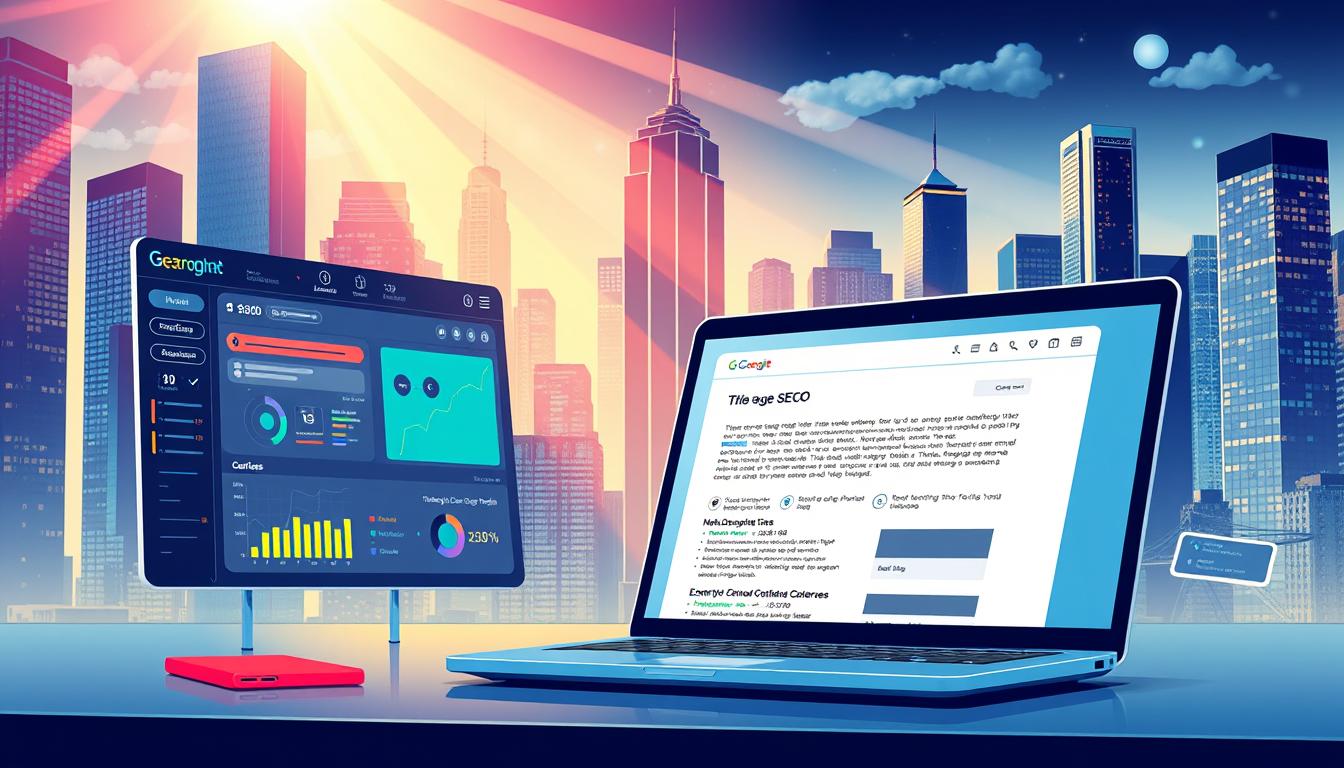In today’s competitive digital landscape, businesses need effective strategies to stand out and drive tangible results. Pay-Per-Click (PPC) advertising has emerged as a powerful tool for achieving immediate visibility and boosting return on investment.
We understand that navigating the complexities of digital marketing can be challenging. That’s why we’re here to guide you through the process of creating a successful PPC campaign that drives real growth for your business.
By leveraging PPC advertising, businesses can reach potential customers at the exact moment they’re searching for relevant products or services. Recent studies show that businesses average $2 in revenue for every $1 spent on Google Ads, highlighting the significant potential of well-executed PPC campaigns.
Key Takeaways
- Understand how PPC advertising works as a cost-effective model for businesses of all sizes.
- Learn proven strategies for maximizing ROI with PPC advertising.
- Discover the importance of keyword selection and landing page optimization.
- Explore advanced techniques for refining your existing PPC strategy.
- Get actionable insights to improve your PPC performance metrics.
The Power of PPC in Today’s Digital Landscape
As consumers increasingly turn to online search for their shopping needs, PPC has become a crucial element in digital marketing strategies. Over 90% of consumers start their shopping journey online, making digital visibility crucial. PPC allows businesses to cut through the noise, placing ads directly in front of users actively searching for relevant products or services.
Unlike organic search results, which can take months to climb rankings, PPC provides immediate access to top positions on search engine results pages (SERPs). This immediacy is key for businesses looking to maximize ROI with PPC quickly and effectively. By leveraging PPC, businesses can enjoy a range of benefits that contribute to their growth and online presence.
Why PPC Matters for Business Growth
PPC matters for business growth because it offers immediate visibility and targeted traffic. By displaying ads to users actively searching for specific products or services, PPC results in higher conversion potential. The pay-per-click model ensures cost efficiency by charging advertisers only when users interact with their ads.
- PPC advertising offers businesses immediate visibility at the top of search engine results pages.
- It delivers targeted traffic by displaying ads to users actively searching for specific products or services.
- The pay-per-click model ensures cost efficiency.
Understanding the PPC Model
The PPC model is based on an auction system where advertisers bid on keywords relevant to their business. The highest bidder, along with the ad’s quality score, determines the ad’s position on the SERP. Understanding this model is crucial for creating effective PPC campaigns.
To illustrate the effectiveness of PPC, let’s examine a comparison of key metrics:
| Metric | PPC | Organic Search |
|---|---|---|
| Visibility | Immediate | Gradual |
| Cost | Cost-per-click | No direct cost |
| Targeting | Highly targeted | Less targeted |
For more insights on maximizing ROI with PPC, you can visit Unlocking the Power of PPC.
How PPC Advertising Works
PPC advertising is a multifaceted marketing approach that requires a deep understanding of its operational framework. At its core, PPC operates on an auction system where advertisers bid for ad placement on search engines and other platforms.
The Mechanics Behind Pay-Per-Click
The mechanics of PPC involve a complex interplay of factors, including keyword bidding strategies, quality scores, and ad extensions. The quality score metric significantly impacts both ad placement and cost-per-click, rewarding advertisers who create relevant, high-quality ads and landing pages. Understanding these technical aspects is crucial for effective PPC management.
| Factor | Impact on PPC | Best Practice |
|---|---|---|
| Keyword Bidding | Influences ad placement and cost | Use targeted keywords with optimal bids |
| Quality Score | Affects ad position and CPC | Create high-quality, relevant ads and landing pages |
| Ad Extensions | Enhances ad visibility and performance | Utilize relevant ad extensions to improve ad rank |
Common Challenges in PPC Management
Managing PPC campaigns effectively is fraught with challenges, including the dynamic pricing model, where costs fluctuate based on competition and market demand for specific keywords. Additionally, cross-platform complexity adds another layer of difficulty, as each advertising platform has its own best practices and nuances. To overcome these challenges, we must adopt a continuous optimization strategy, regularly monitoring and adjusting campaigns to ensure optimal ROI and performance.
Strategic Keyword Selection for Maximum Impact

The foundation of any successful PPC campaign lies in strategic keyword selection. This involves more than just identifying relevant terms; it’s about understanding user intent and aligning your ads with the search queries that drive conversion.
Conducting Effective Keyword Research
To start, we use tools like Google’s Keyword Planner to identify high-value keywords with optimal search volume and competition levels. This helps us create a targeted keyword strategy that improves ad visibility and click-through rates.
Long-Tail vs. Short-Tail Keywords
Long-tail keywords (phrases with 3+ words) often deliver better ROI despite lower search volume, as they target users with higher purchase intent. In contrast, short-tail keywords are broader and more competitive. We help you strike a balance between the two to maximize your campaign’s effectiveness.
Using Negative Keywords to Refine Your Campaign
Negative keywords play a critical role in refining campaigns by preventing your ads from showing for irrelevant searches. This reduces wasted spend and improves campaign focus, ensuring that your budget is allocated efficiently.
For more insights on optimizing your PPC campaigns, visit our resource page at https://affiliatesecrets.14u.info/hello-world/. By implementing these strategies, you can significantly enhance your campaign’s performance and achieve a higher ROI.
Smart Budget Allocation Techniques
Smart budget allocation is fundamental to PPC success, as it allows businesses to make the most out of their advertising spend. Allocating your budget effectively is crucial for maximizing ROI with PPC. As emphasized by industry experts, “Understanding your budget and how it impacts your campaign’s performance is key to achieving your advertising goals.”
To allocate your budget effectively, you need to research industry benchmarks and investigate the average Cost-Per-Click (CPC) in your sector. This helps you establish realistic expectations for CPC and return on ad spend. By comparing your budget to industry standards, you can identify areas for improvement.
Setting Your Initial PPC Budget
When setting your initial PPC budget, it’s essential to start with a conservative amount. This allows for testing and data collection before scaling up investment in proven performers. Defining clear cost-per-acquisition (CPA) targets based on customer lifetime value ensures your PPC investment remains profitable in the long term.
- Research industry benchmarks to establish realistic expectations for CPC and return on ad spend.
- Define your CPA target by calculating the maximum you’re willing to spend to acquire a customer.
- Start with a conservative budget to test and gather data.
Scaling Based on Performance Data
Once you have collected sufficient data, you can scale your budget based on performance. Leveraging automated bidding strategies like Target CPA or Maximize Conversions can optimize your spend efficiency through machine learning algorithms. Performance-based budget allocation directs more resources to high-performing keywords and campaigns while reducing investment in underperforming elements.
By analyzing campaign data, you can make informed decisions about where to increase, decrease, or maintain your budget allocation. This ensures that your PPC campaign continues to perform optimally and provides a strong ROI.
Essential Metrics for Maximizing ROI with Pay-Per-Click Advertising
To maximize ROI with PPC advertising, it’s crucial to focus on the right metrics that drive campaign success. By understanding and tracking these essential metrics, we can make data-driven decisions to optimize our PPC campaigns and improve their overall performance.
Key Performance Indicators to Track
Tracking the right metrics is vital for evaluating PPC campaign performance. Key performance indicators (KPIs) such as Click-Through Rate (CTR), Conversion Rate, Cost Per Conversion (CPC), Return on Ad Spend (ROAS), and Quality Score provide valuable insights into campaign effectiveness.
- CTR measures ad relevance and appeal, calculated as (Number of Clicks / Number of Impressions) x 100.
- Conversion Rate indicates the effectiveness of both ads and landing pages in turning clicks into meaningful business actions.
- CPC measures the efficiency of ad spend, with the goal of lowering this metric while maintaining or increasing conversion volume.
Advanced Measurement Strategies
Beyond basic metrics, advanced measurement strategies can further enhance PPC campaign performance. Implementing conversion tracking, utilizing analytics tools, monitoring assisted conversions, and conducting regular audits can provide a more comprehensive understanding of campaign impact.

By incorporating these advanced strategies and focusing on key performance indicators, we can optimize our PPC campaigns for maximum ROI and continued improvement.
Optimizing Quality Score and Ad Placement

Improving your Google Ads Quality Score can lead to better ad placements at lower costs. Quality Score is Google’s rating of the quality and relevance of your keywords, ads, and landing pages. It significantly influences both ad placement and cost-per-click (CPC).
To optimize Quality Score, we need to focus on two critical areas: crafting compelling ad copy and leveraging ad extensions effectively.
Crafting Compelling Ad Copy
Crafting compelling ad copy requires aligning your messaging with targeted keywords and addressing specific user search intent. Effective ad copy must balance attention-grabbing headlines with clear value propositions and strong calls-to-action that motivate clicks.
By doing so, we can improve our ad’s relevance, increasing the likelihood of a higher Quality Score and better ad placement.
Leveraging Ad Extensions Effectively
Ad extensions provide additional information like site links, callouts, or location details, making our ads more prominent and informative without increasing our bid. Implementing ad extensions can significantly improve click-through rates by providing users with more reasons to engage with our advertisement.
By regularly reviewing and refining our keywords, ad copy, and extensions, we can maintain and improve our Quality Score over time, leading to more effective PPC campaigns.
Landing Page Optimization for Conversion

Landing page optimization plays a pivotal role in maximizing ROI for PPC campaigns. A well-optimized landing page continues the seamless user experience that began with your ad, increasing the likelihood of conversion and improving your overall campaign performance.
To achieve this, several key strategies must be employed. Ensuring strong alignment between your ad copy and landing page content is crucial. If your ad promises a specific offer or solution, your landing page should deliver on that promise immediately.
Creating Alignment Between Ads and Landing Pages
Creating strong alignment between ad copy and landing page content ensures a seamless user experience and delivers on the promises made in your advertisements. This alignment is critical for maintaining user trust and encouraging conversion.
Key elements to focus on include headline consistency, visual coherence, and clear messaging that resonates with your target audience.
Designing for Conversion: Best Practices
Effective landing pages feature clear, compelling calls-to-action (CTAs) that stand out visually and communicate value propositions concisely. Minimizing distractions and navigation options helps focus visitor attention on the desired conversion action.
Additionally, page load speed and mobile optimization are critical factors. A/B testing different landing page elements provides data-driven insights for continuous improvement, while tools like heat maps and session recordings can reveal how users interact with your pages.
A/B Testing Your PPC Campaigns
A/B testing is the cornerstone of optimizing PPC campaigns for better performance and ROI. By creating two similar ads or landing pages and changing one element at a time, you can determine which version performs better. This data-driven approach helps you make informed decisions rather than relying on assumptions.
Key Elements to Test
When it comes to A/B testing in PPC campaigns, there are several key elements worth testing. These include ad headlines, copy variations, calls-to-action, landing page designs, and audience targeting parameters. By testing these elements, you can identify which variations drive performance improvements.
- Test ad headlines to see which ones attract more clicks.
- Experiment with different copy variations to improve conversion rates.
- Optimize calls-to-action to enhance user engagement.
Implementing Test Results
Effective A/B testing isn’t just about running tests; it’s about implementing the results to drive continuous improvement. Once you’ve identified winning variations, roll them out across your campaigns. Then, continue testing new hypotheses to further optimize your PPC campaigns. Even small improvements in click-through rates or conversion rates can significantly impact overall campaign ROI when applied consistently.
By prioritizing testing efforts based on potential impact, you can focus on elements most likely to drive meaningful performance improvements. This systematic approach ensures that your PPC campaigns continue to evolve and improve over time.
Advanced PPC Strategies for Specific Business Types
To get the most out of PPC advertising, businesses must adopt type-specific strategies. Different business types have unique goals, audience behaviors, and conversion paths, requiring tailored PPC approaches. By understanding these differences, businesses can create more effective campaigns that drive meaningful results.
For instance, local businesses can significantly benefit from geotargeting capabilities that allow them to display ads only to users in specific geographic areas. This maximizes budget efficiency, especially for brick-and-mortar locations. Location extensions and local inventory ads can also help drive foot traffic by showing nearby customers the business’s address, business hours, and available products.
Local Business PPC Tactics
Local businesses can enhance their PPC campaigns by utilizing geotargeting to cater to different audiences across various locations. This allows for a degree of customizability in marketing efforts to meet diverse preferences and needs. By running location-specific campaigns, local businesses can increase their relevance and appeal to the target audience.
- Use geotargeting to display ads to users in specific geographic areas.
- Leverage location extensions to provide nearby customers with essential business information.
E-commerce PPC Optimization
E-commerce businesses can optimize their PPC campaigns by leveraging shopping campaigns that showcase products with images, prices, and store information directly in search results. Additionally, price extensions allow businesses to display product information along with prices below the main part of their ad. Dynamic remarketing is another powerful tool that enables e-commerce sites to show previous visitors the exact products they viewed, significantly increasing conversion rates.

- Utilize shopping campaigns to showcase products directly in search results.
- Implement dynamic remarketing to target previous visitors with relevant products.
Tools and Platforms to Enhance Your PPC Performance

In the realm of digital marketing, PPC tools play a pivotal role in campaign optimization. To manage complex PPC campaigns efficiently and identify optimization opportunities, leveraging the right tools and platforms is essential.
Several platforms offer a range of features that can enhance PPC performance. Google Ads remains the dominant platform with the largest reach, offering sophisticated features like automated bidding, responsive search ads, and extensive audience targeting options.
Google Ads and Microsoft Advertising Features
Google Ads and Microsoft Advertising provide a robust set of features, including ad extensions, automated bidding strategies, and audience targeting options. Microsoft Advertising, formerly Bing Ads, offers access to the Bing, Yahoo, and AOL search networks, often with less competition and lower cost-per-click than Google.
Third-Party PPC Management Solutions
Third-party management tools like SEMrush, WordStream, and Optmyzr provide cross-platform campaign management, advanced reporting, and automation features. These tools can help streamline campaign management, provide advanced analytics, and offer additional optimization features beyond what’s available in the native platforms.
By utilizing these tools and platforms, businesses can optimize their PPC campaigns more effectively, leading to improved ROI and increased leads.
Conclusion: Taking Your PPC Strategy to the Next Level
Effective PPC management is not a one-time task but an ongoing process that involves continuous testing, measurement, and improvement. To maximize ROI with pay-per-click advertising, businesses must adopt a comprehensive approach that integrates all the strategies we’ve discussed.
Key Takeaways for Successful PPC Campaigns:
- Regularly refine your PPC campaigns based on performance metrics and market changes.
- Stay updated with the latest platform updates and industry trends to maintain a competitive edge.
- Integrate PPC with other marketing channels like organic search and content marketing for a cohesive strategy.
- View PPC as an investment with measurable returns, allocating budget based on performance data.
- Leverage automation and machine learning tools to scale your efforts while maintaining personalization.
For businesses looking to elevate their PPC strategy, our free complete marketing suite offers valuable resources and tools. Visit leap.14u.info to access these assets and take your PPC campaigns to the next level.
Get Your Free Complete Marketing Suite
Get instant access to our free complete marketing suite and start optimizing your PPC campaigns today by visiting leap.14u.info.
Our comprehensive toolkit is designed to help businesses like yours maximize their advertising ROI. It includes keyword research templates, budget planning spreadsheets, and conversion tracking guides.
With our suite, you’ll also gain access to expert-crafted ad copy templates and landing page frameworks that drive higher click-through rates and conversions.
FAQ
What is the primary goal of a PPC campaign?
Our primary goal is to drive conversions, whether that’s generating leads, making sales, or promoting brand awareness, while ensuring a strong return on ad spend.
How do we determine the optimal PPC budget for our business?
We consider factors such as industry benchmarks, campaign goals, and target audience to set an initial budget, then scale based on performance data to optimize our spend.
What role does keyword research play in a successful PPC campaign?
Effective keyword research helps us identify relevant terms and phrases, including long-tail and short-tail keywords, to target our audience and refine our campaign for better results.
How can we improve our Quality Score and ad placement?
We focus on crafting compelling ad copy, leveraging ad extensions, and ensuring alignment between our ads and landing pages to improve our Quality Score and ad placement.
What is the importance of A/B testing in PPC campaigns?
A/B testing allows us to experiment with different ad elements, such as copy and targeting, to identify top-performing variations and implement data-driven decisions for continuous improvement.
How do we measure the success of our PPC campaigns?
We track key performance indicators such as conversion rates, cost per conversion, and return on ad spend to evaluate campaign performance and make data-driven decisions.
Can PPC campaigns be effective for local businesses?
Yes, we use location targeting and other local business PPC tactics to help businesses reach their target audience and drive conversions in their specific geographic area.
What tools and platforms can enhance our PPC performance?
We utilize Google Ads and Microsoft Advertising features, as well as third-party PPC management solutions, to streamline our campaigns, improve efficiency, and drive better results.



















 Pinterest is often overlooked as a significant SEO platform, but it offers substantial benefits. With 518 million monthly active users, it thrives on aesthetic, niche content. Pinterest functions more like a search engine than a traditional social network, with users actively searching for ideas, products, and inspiration. The platform’s pins have remarkable longevity, often continuing to drive traffic months or even years after publication. By optimizing our Pinterest presence with relevant keywords and high-quality images, we can tap into this long-tail traffic and improve our overall SEO performance.
Pinterest is often overlooked as a significant SEO platform, but it offers substantial benefits. With 518 million monthly active users, it thrives on aesthetic, niche content. Pinterest functions more like a search engine than a traditional social network, with users actively searching for ideas, products, and inspiration. The platform’s pins have remarkable longevity, often continuing to drive traffic months or even years after publication. By optimizing our Pinterest presence with relevant keywords and high-quality images, we can tap into this long-tail traffic and improve our overall SEO performance.




























